Looking for a houseplant that’s as low-maintenance as your ex? Meet Anthurium clarinervium! This “velvet cardboard” anthurium is so easy to care for even your goldfish could keep it alive (well, maybe not).
Anthurium clarinervium, a.k.a. the cardboard anthurium, got its moniker from its leaf game – thick, dark green leaves as stiff as a board.
Endowed with an almost velvety texture, it exudes an undeniable allure.
Its distinctive heart-shaped leaves with white veins make it a popular tropical plant and a centerpiece in interior design projects and a reason for this blog. So let’s dive right in.
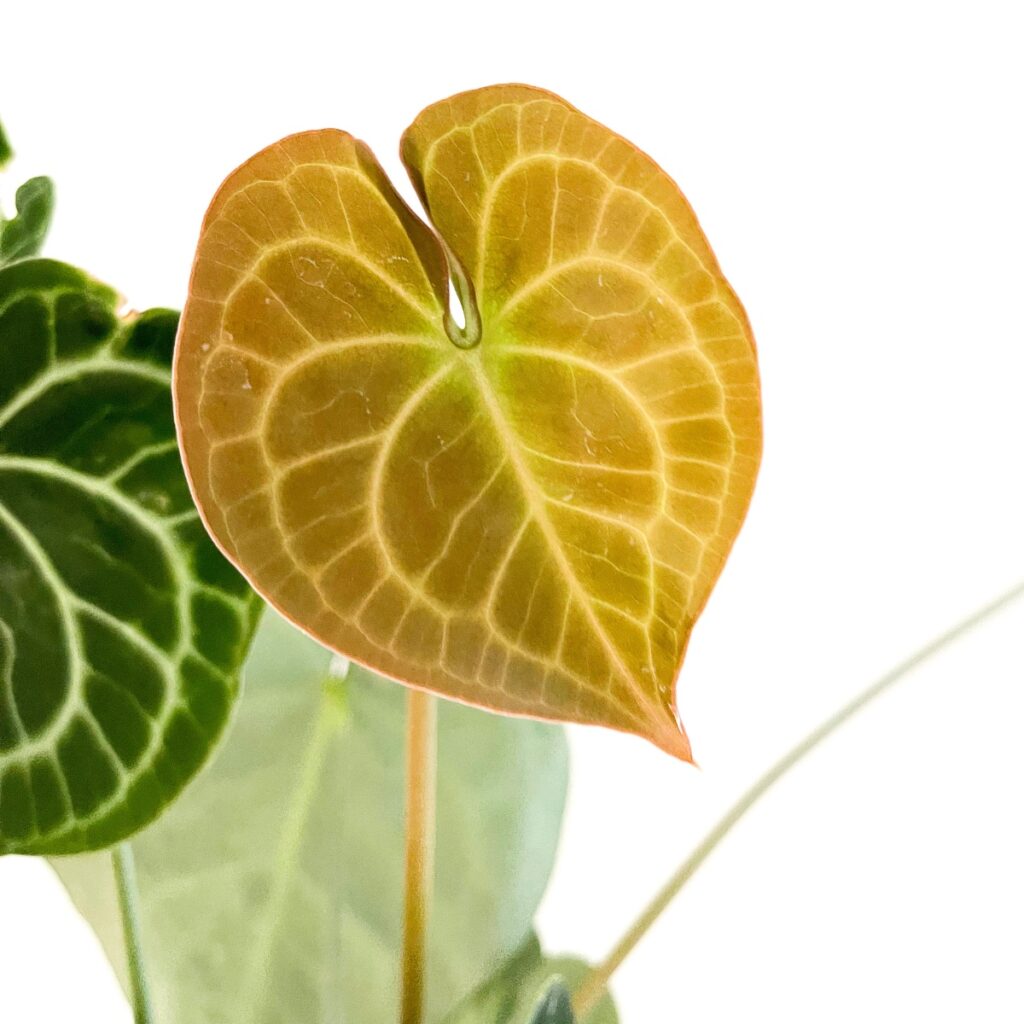
Physical Characteristics of Anthurium Clarinervium
The origins
Anthurium clarinervium is a terrestrial type of anthurium species native to southern Mexico, specifically in the state of Chiapas. In its natural habitat, it has been found growing on limestone outcrops at elevations between 800-1200 meters above sea level.
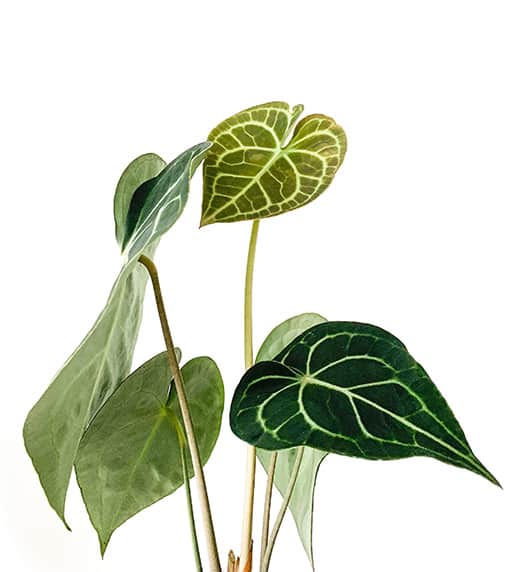
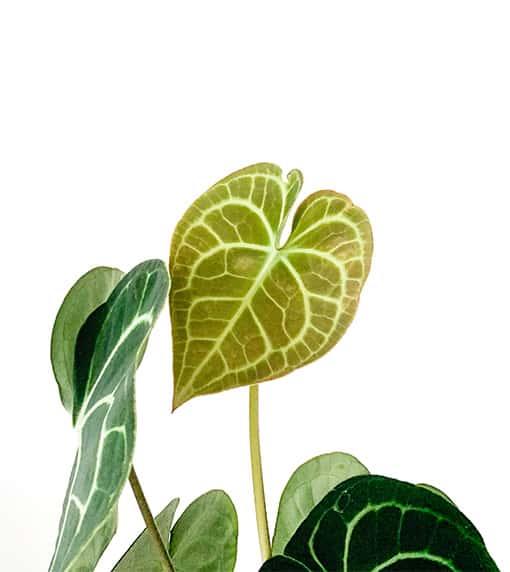
Leaf shape, size, texture, & color
Anthurium clarinervium is also known as cardboard anthurium due to its thick dark green leaves that feel like, well, like cardboard. It has one of the most unique heart-shaped leaves with dark velvety blades and stark white veins. Unlike similar-looking anthurium species such as Anthurium magnificum or crystallinum, these velvet cardboard anthurium leaves are very thick and difficult to bend. Another difference from other heart-shaped anthuriums is that Anthurium clarinervium leaves won’t grow as big.
Anthurium clarinervium has one of the darkest matte green leaves among anthuriums. The lobes meet and overlap, giving them a very characteristic look. The abaxial side of the leaves is much lighter in color.
The new growth emerges brown before turning green at maturity.
Inflorescence, pollen & berries
The inflorescences are not spectacular, but they seem to always tower well above the leaves. It is not unheard of for Anthurium clarinervium plants to push multiple inflorescences simultaneously.
The pollen is quite chunky, with large granules, unlike other anthuriums with more powdery pollen. The berries are bright orange in color. If you’re lucky to pollinate your clarinervium, you must be patient as the berries take very long to develop. It will take 8-12 months for the berries to ripen.
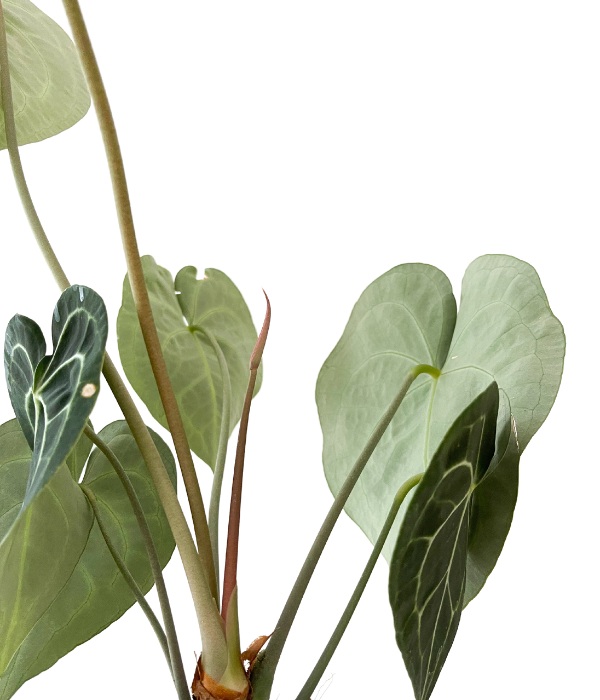
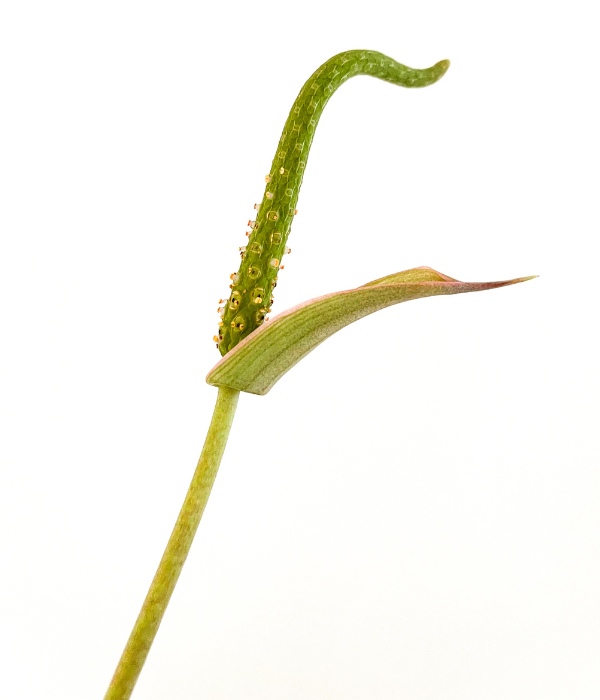
Anthurium clarinervium was classified for the longest time to belong to the Cardiolonchium section along with Anthurium crystallinum, magnificum, and warocqueanum, among others. But recently, it was classified as belonging to the section Andiphilum. Check out some cool Anthurium clarinervium hybrids at the end of this post.
Roots
Anthurium clarinervium plants have very thick but brittle roots. Given their habitat growing on rocks, the roots adapted to anchor them to the surface, absorbing nutrients and moisture from the air and rainfall. Getting the potting medium and watering right is critical to avoiding root rot with this anthurium. But more on this later on.
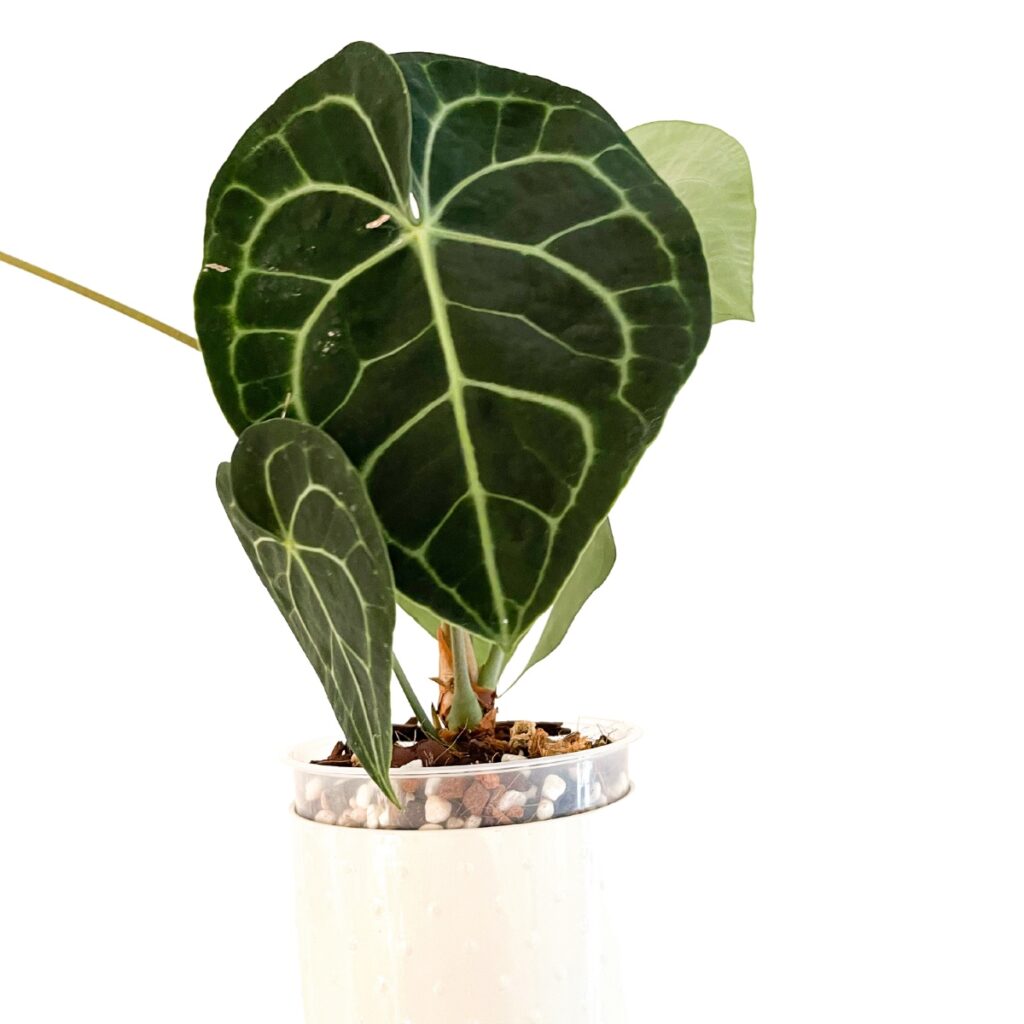
Anthurium Clarinervium Care: How to Grow It Like a Pro
So, apparently, having indoor plants not only makes you look like a cool and trendy plant parent but also helps you breathe better and calm down after a long day of adulting. Who knew plants could be so damn useful?
The velvet cardboard plant requires minimal care and can thrive in average humidity. Whether you’re a seasoned plant parent or a complete newbie, this plant will impress without making you break a sweat (or the bank).
So let’s dive into Anthurium clarinervium plant care.
Light
This velvet cardboard hottie loves attention so much that it can’t help but lean towards the light like a Kardashian to a camera. If you want your clarinervium to look like a perfectly symmetrical Instagram post, you better rotate it regularly while it’s basking on the windowsill. But hey, if you’re growing it under grow lights, you won’t have to deal with this diva’s spotlight-seeking shenanigans.
But in all seriousness, lower light levels are not a problem for this anthurium, although it won’t be throwing new leaves or inflorescences as often as if put in brighter light. It is one of the more adaptable anthuriums and will grow well during the fall and winter.
It tends to spread the leaves’ petioles, similar to what Anthurium forgetii does.
A bright indirect light is perfect for Anthurium clarinervium. The direct sunlight will scorch the leaves, so avoid having them in an unobstructed window for prolonged periods but filtered sunlight is ideal. Check out my guide if you want a deeper dive into anthurium light requirements. It covers what bright indirect light means and how to measure it correctly—Demystify anthurium clarinervium light requirements by reading my lighting guide.
Potting soil
One of the more important factors when it comes to anthurium clarinervium care is having the right potting mix. I always opt for extra chunky aroid soilless potting mix, which will ensure two things: 1) the water can drain fast through the mix, and it never becomes waterlogged, 2) the roots have large particles to attach themselves to, such as orchid bark.
Skip the cheap potting soil and mix up your own batch of premium potting mix. Start with a base of coco peat* and high-quality orchid bark, add some large perlite or coarse sand for drainage, and throw in a handful of charcoal to fend off diseases. Add a bit of sphagnum moss to trap moisture and help those roots grow and thrive. And if you really want to give your Anthurium clarinervium the royal treatment, sprinkle in some worm castings or compost for some extra nutrients. With the right potting mix, your Anthurium clarinervium will live its best life in no time!
*I’m not a fan of peat moss and don’t use it in my aroid mixes anymore.
Anthuriums generally like to be on the rootbound side, but if you’re in doubt, check out my guide to anthurium repotting for all you ever need to know when it comes to repotting.
Temperature
The ideal temperature range for an Anthurium clarinervium plant is between 18°C to 28°C (65°F to 82°F), and it does not tolerate temperatures below 12°C (54°F). However, it’s important to note that the velvet cardboard anthurium is sensitive to direct sunlight and high temperatures, so it’s best to provide it with bright, indirect light and avoid placing it near heating or cooling vents. As it is a tropical plant, warm temperatures year-round are ideal for this plant.
Water
Anthurium clarinervium loves humidity and moisture around its fleshy roots. Anthurium clarinervium plant is prone to oedema when excess water accumulates in the cells of the leaves. It won’t harm your anthurium but try to water your plant in the morning when it has plenty of time to evaporate or use the excess water. Provide an extra chunky potting mix that allows for fast drainage; overwatering and root rot will not be an issue.
Make sure to dust the leaves now and then to allow for photosynthesis. Put them under a shower to clean off dust, or use a damp microfiber cloth to clean the leaves.
For an in-depth guide on watering anthuriums, check out my other blog: Water Like a Pro: An Essential Guide to Anthurium Watering.
Humidity
Well, humidity can take a hike because Anthurium clarinervium is a boss and will thrive in average house humidity. All my anthuriums, including Anthurium clarinervium, live in ambient room humidity of around 50-55%. High humidity is unnecessary for this anthurium, although consistent high humidity will do wonders.
If you see browning tips of the leaves, it might be a sign that you need to increase watering frequency or humidity around your anthurium.
Common issues & problems
Anthurium clarinervium is like the laid-back cousin of the diva queen anthurium. It’s a low-maintenance plant that won’t give you too much trouble. However, just like any plant, there are a few hiccups you might run into while tending to your clari. Let’s have a look, shall we?
Root rot
Root rot can happen if the plant is overwatered or sitting in a pot without proper drainage. To prevent root rot, ensure your plant is in a well-draining pot and only water it when the soil can dry out. Anthuriums generally prefer constant moisture, yet this specimen flourishes under slightly drier conditions.
Some signs of root rot are mushy brown roots and yellowing leaves. If you suspect your clarinervium has root rot, it’s best to take action quickly by inspecting the root system, removing any affected roots, and repotting the plant in a fresh, dry potting mix. And cut off the yellow leaves. Trust me, your velvet cardboard anthurium will thank you for it!
Fungal & bacterial infections
Fungal infections often show up as spots on the leaves or stem, while bacterial infections may cause blackening or softening of the stem or roots. To prevent fungal and bacterial infections, providing your anthurium plant with a suitable growing environment with a proper potting mix, the correct watering, and good air circulation is essential. If you notice signs of infection, take action promptly by treating the plant with appropriate fungicides or bactericides to prevent the spread of the infection. If you can stomach it, cut off the affected foliage as the diseases spread to other leaves.
Pests
Spider mites or thrips are the most prevalent pests on your anthuriums. I’ve yet to have any infestation on this velvet cardboard anthurium, and it grew next to a Philodendron gloriosum which is spider mites’ favorite. Thankfully Anthurium clarinervium plants are relatively resistant to these pests. Insecticidal soap spray will do its magic, fending off the intruders.
Propagation Methods
You have several options for Anthurium clarinervium propagation.
Seed propagation
Propagating anthurium clarinervium through pollination is one of the most satisfying ways for a houseplant enthusiast. But arm yourself in patience as the berries take very long to develop. If you’re successful, the berries will take 8-12 months to develop and ripen. They will be round and orange and will pop out when fully ripened. Remove the single seed from a berry, place it on a damp sphagnum moss, and enjoy growing little seedlings.
Stem cutting propagation
If you want to avoid going through the pollination route, the stem-cutting method is a faster way to get a new plant. Cut the stem below the node, root the top cutting in moss while the bottom part of the stem grows new offshoots. And voila, soon you’ll have two new plants.
How to tell the difference between Anthurium clarinervium and other anthurium species
Anthurium Clarinervium vs Anthurium Crystallinum
Anthurium clarinervium can sometimes be confused with other popular anthurium species, such as Anthurium crystallinum or magnificum.
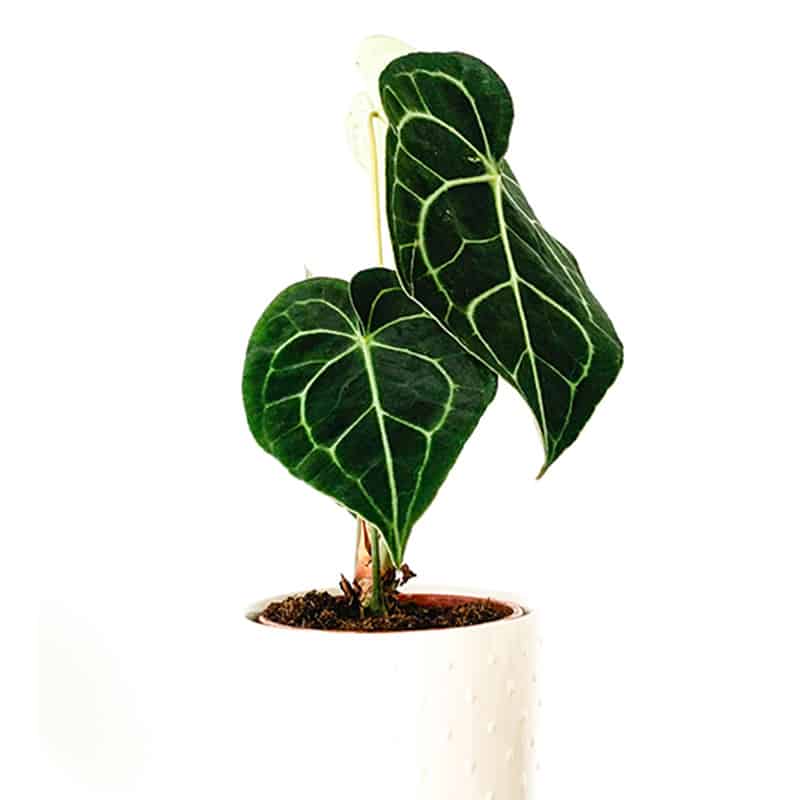
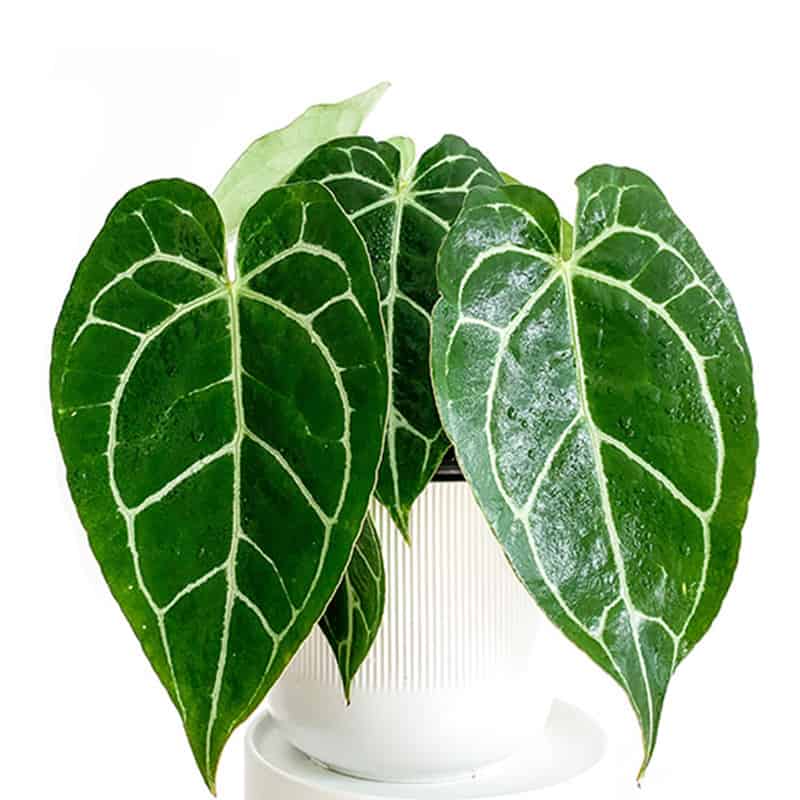
But you can quickly tell the difference between anthurium clarinervium and crystallinum by looking at the veins’ leaf shape, size, and patterns. Clarinervium has much rounder leaves and very characteristic vein patterns. Anthurium crystallinum leaves grow much larger in size and have elongated shapes.
Anthurium Clarinervium vs Anthurium Magnificum
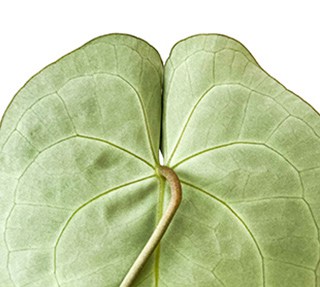
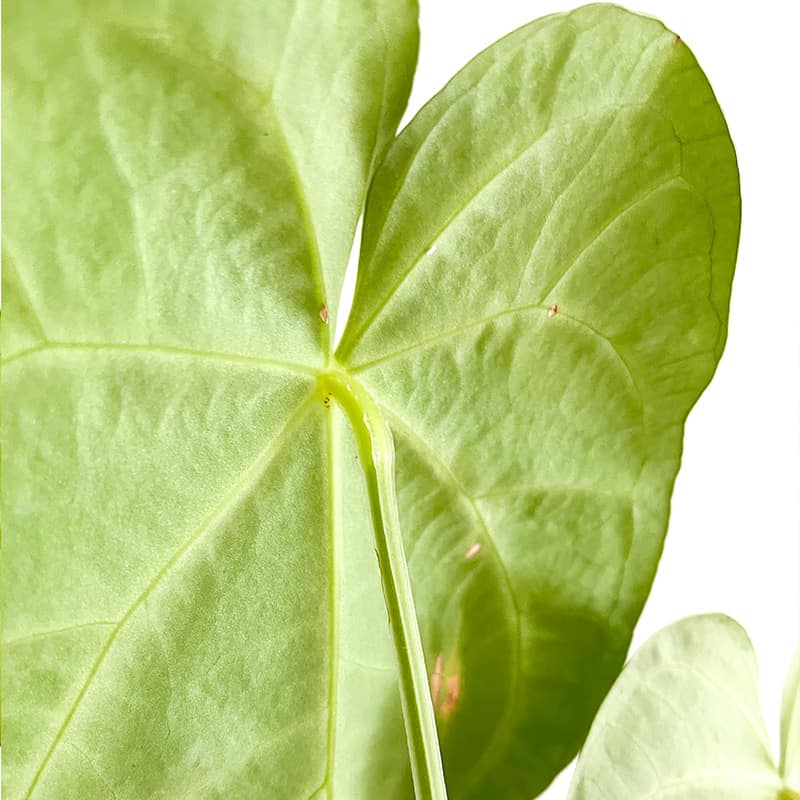
The easiest way to tell the difference between anthurium clarinervium and magnificum is to look at the petioles. Anthurium magnificum has squarish petioles that can be ruffled at the edges, while clarinervium has them perfectly rounded.
Anthurium Clarinervium vs Anthurium Leuconeurum
While Anthurium clarinervium has quite a distinctive look, it can be confused with a similar-looking Anthurium leuconeurum. But, Anthurium leuconeurum has larger leaves, less distinct veins, and a wider gap between the lobes. Some anthurium growers think Anthurium leuconeurum could be a hybrid rather than a true species. The possible parentage of Anthurium leuconeurum could be Anthurium berriozabalense and Anthurium clarinervium.
Anthurium clarinervium hybrids
Anthurium Pterodactyl = Anthurium Clarinervium x Anthurium Pedatoradiatum
When you cross Anthurium clarinervium with Anthurium pedatoradiatum, you’ll get Anthurium Pterodactyl, also known as Anthurium Macrolobium.
Anthurium clarinervium is often hybridized with pedatoradiatum, which grows in the same natural habitat of limestone outcrops in southern Mexico. The hybrid has the velvety texture of clarinervium but with a shallowly lobed margin characteristic of pedatoradiatum.
Anthurium ‘Delta Force’ = a select clone of Anthurium Clarinervium x Anthurium Pedatoradiatum
You’d think that when you cross your Anthurium clarinervium with Anthurium pedatoradiatum, you will get the highly desirable Anthurium Delta Force, right? Wrong!
Anthurium ‘Delta Force’ is a select clone of the A. clarinervium x A. pedatoradiatum hybrid, which means it was selected among all the other seedlings because it exhibited unusual characteristics. Many have tried to recreate this hybrid over the years but to no avail. They were not able to create the same-looking plant as the Delta Force. That tells you how much variation it can be in a single batch of seedlings.
The key standout feature of this highly regarded hybrid is the triangle or delta-shaped leaf blade with a very sharp apex. It is slightly wavy or, as experts say, undulated margins and lost all of the ‘fingers’ characteristic of Anthurium pedatoradiatum.
Anthurium Delta force can only be reproduced by stem cuttings.
Anthurium King Clarinervium
Anthurium King Clarinervium is a mutation from regular Anthurium clarinervium seedlings. It exhibits an elongated leaf shape, larger leaf blades, and a slightly different veining structure. The veins are also much brighter.
Anthurium Queen Clarinervium
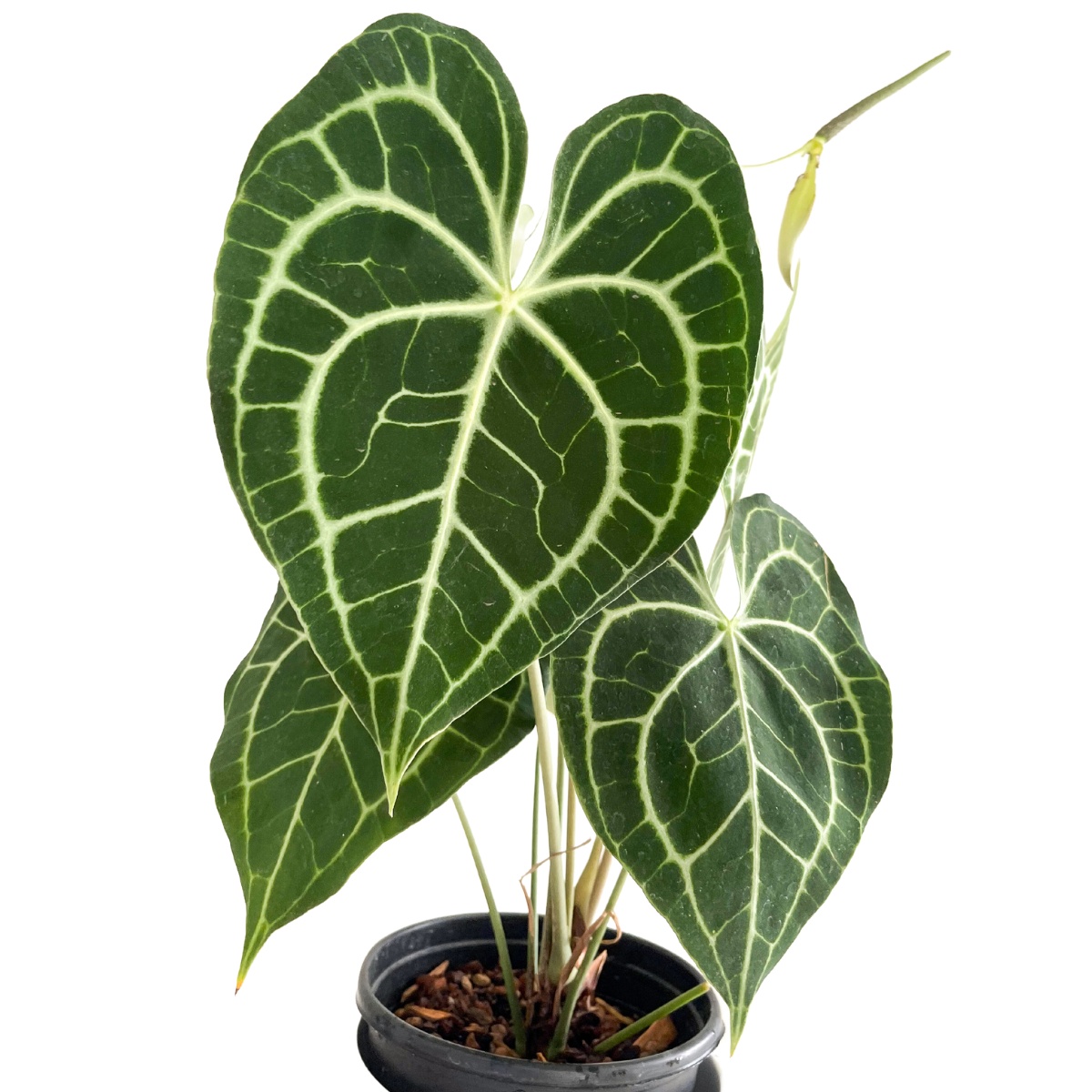
Anthurium Queen Clarinervium is an unknown hybrid of Anthurium Clarinervium. It is a beautiful plant, and when I had a chance to own it, I jumped at this opportunity. The compact look of this anthurium plant makes it stand out among other anthurium plants. It currently has a receptive inflorescence, and I tried to pollinate it with stored pollen from a regular-looking Anthurium clarinervium. Let’s see if I was successful.
One interesting observation is that the receptive fluid seems to be more sticky than those of magnificum or crystallinum. Also, it already produced pollen while still exuding the fluid, which usually comes first and stops immediately when pollen starts to produce. This is designed by nature to prevent self-pollination. I’m excited to see if I was successfully pollinating this amazing anthurium plant.
Other less known crosses of Anthurium Clarinervium
Anthurium Clarinervium x Berriozabalense, x Faustomirandae, x Seleri, x Luzense, and x Ochranthum.
Anthurium clarinervium has become popular with interior designers and plant enthusiasts thanks to its striking appearance and unique characteristics. It is often used as a statement plant in minimalist and modern interiors, adding a touch of tropical luxury and exotic flair. If you want to elevate your space with a touch of a tropical jungle, Anthurium clarinervium is your plant.

